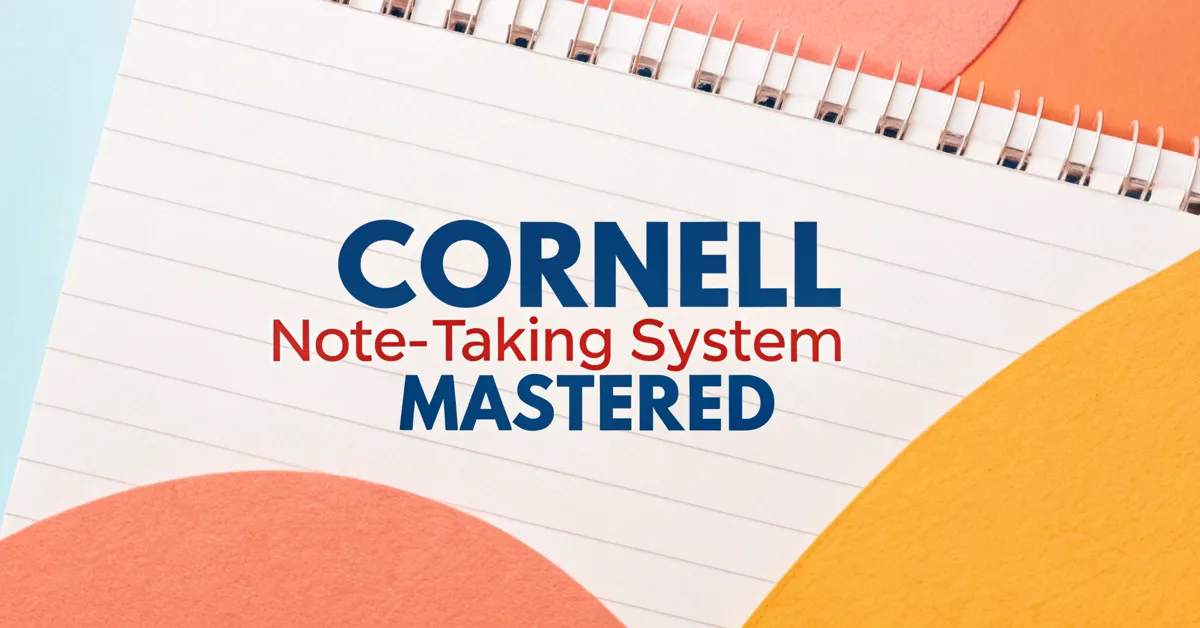Note-taking can be a real struggle. You sit through a long lecture, scribble down what you think is important, and then… what? You’re left with a page of barely legible notes that make little sense when you revisit them. Is there a method to this madness?
There is. It is called Cornell notes.
In this article, you’ll learn how to master the Cornell notes and unlock a powerful way to learn, remember, and review information. This simple yet structured method can transform you to be a student who can easily study. Let’s dive in.
What are Cornell Notes?
The Cornell notes system is a method of note-taking designed to help students actively engage with and retain information from lectures, readings, or other learning experiences. Developed in the 1950s by Walter Pauk, an education professor at Cornell University, this system provides a structured format for organizing and reviewing notes.
The core idea behind Cornell notes is to break down a page into specific sections, each serving a distinct purpose in the learning process. This includes a note-taking area for recording information, a cue column for formulating questions and keywords, and a summary section for condensing the main points. The visual organization and active engagement make it a popular tool for students of all levels.
Here’s why it stands out:
- Organization: The structure helps organize notes in a clear and logical way.
- Active Recall: The cue column encourages active recall and deeper understanding.
- Efficient Review: Summaries provide a quick and effective way to review material.
Why Use the Cornell Note-Taking System?
Why should you try Cornell notes when so many other note-taking methods exist? Here are several reasons:
- Improved Comprehension: By actively summarizing and reviewing notes, comprehension is improved. One study, published in the Journal of College Reading and Learning, found that students who used structured note-taking methods, like Cornell notes, demonstrated better recall and understanding of lecture material compared to those who used unstructured methods.
- Enhanced Retention: The system promotes active recall, a technique proven to boost memory retention. A study in Educational Psychology Review highlights that active recall is more effective than passive review for long-term retention of information.
- Better Organization: The structured format ensures that notes are well-organized and easy to navigate. This can save time and reduce stress when studying for exams or completing assignments.
- Active Learning: Cornell notes encourage active engagement with the material, rather than passive listening or reading. This can make learning more enjoyable and effective.
- Effective Study Tool: The system provides a built-in study guide with key points, questions, and summaries, making it easier to review and reinforce learning.
- Versatility: The Cornell method can be adapted for various subjects and learning environments, whether in lectures, seminars, or self-study sessions.
- Time Efficiency: While it may take a bit of practice to get used to, the structured approach can ultimately save time by streamlining the note-taking and review process.
- Critical Thinking: Formulating questions and summarizing information encourages critical thinking and deeper analysis of the material.
- Test Preparation: Cornell notes serve as an excellent resource for test preparation, providing a comprehensive and organized set of notes to study from.
- Engagement: The active nature of the system keeps students engaged during lectures and study sessions, reducing distractions and improving focus.
How to Set Up Your Cornell Notes Page
Before diving into taking Cornell notes, it’s key to set up your page. Here’s how to do it:
-
Divide the Paper: Take a sheet of paper (or a digital document) and divide it into three sections.
- Note-Taking Area: This should be the largest section, typically taking up about two-thirds of the page. It’s where you’ll record the main points, details, and explanations from the lecture or reading.
- Cue Column: This is a narrow column on the left side of the page, about 2.5 inches wide. It’s used for writing keywords, questions, and prompts that will help you review and recall the information later.
- Summary Section: This is a section at the bottom of the page, about 2 inches high. It’s used for summarizing the main ideas and key points from the notes above.
-
Label Each Section: Clearly label each section to avoid confusion. Write “Notes” at the top of the note-taking area, “Cues” at the top of the cue column, and “Summary” at the bottom section.
-
Choose Your Medium: Decide whether you’ll be using paper and pen or a digital note-taking tool. Both have their advantages. Paper is tactile and doesn’t require power, while digital tools offer flexibility, searchability, and easy editing.
-
Prepare Multiple Pages: Set up several pages in advance so you can easily continue taking notes without having to stop and draw the layout each time.
-
Customize as Needed: Feel free to adjust the dimensions of each section based on your personal preferences and the nature of the material. For example, if you anticipate needing more space for summaries, you can increase the size of the summary section.
Steps to Mastering the Cornell Notes
Now that you’ve set up your page, it’s time to learn how to use the Cornell notes effectively.
Step 1: Record (During the Lecture or Reading)
The first step in the Cornell note-taking system is to record as much meaningful information as possible in the note-taking area during the lecture or reading. Here’s how to make the most of this step:
- Capture Main Ideas: Focus on capturing the main ideas, key concepts, and supporting details. Don’t try to write down every word. Instead, listen actively and identify the most important points.
- Use Abbreviations and Symbols: Develop a system of abbreviations and symbols to speed up your note-taking. For example, use “&” for “and,” “w/” for “with,” and arrows to indicate relationships between concepts.
- Paraphrase: Rephrase information in your own words to better understand and remember it. This also helps you avoid simply copying down information without processing it.
- Organize with Indentation: Use indentation to show the relationship between main ideas and supporting details. This makes your notes easier to read and understand later.
- Skip Lines: Leave blank lines between ideas or topics to create visual separation and make your notes easier to review.
- Be Selective: Focus on recording information that is new, surprising, or particularly important. If something is already familiar to you, it may not be necessary to write it down.
- Listen Actively: Pay close attention to the speaker or author and try to understand the context of the information. This will help you prioritize what to record and make your notes more meaningful.
- Note Key Terms: Write down any key terms or vocabulary words that are introduced, along with their definitions or explanations.
- Record Examples and Illustrations: Include examples, illustrations, and anecdotes that help clarify the main ideas. These can be particularly helpful when reviewing your notes later.
- Capture Questions: If you have questions during the lecture or reading, jot them down in the note-taking area. You can then research the answers later or ask the instructor for clarification.
Step 2: Reduce (After the Lecture or Reading)
The second step in the Cornell note-taking system involves reducing your notes into concise cues and questions in the cue column. This step is key for reinforcing your understanding and preparing for review. Here’s how to do it effectively:
- Review Your Notes: As soon as possible after the lecture or reading, review your notes in the main note-taking area. This helps you solidify the information in your mind and identify any gaps or areas of confusion.
- Identify Key Concepts: Look for the main ideas, key terms, and essential details in your notes. These are the concepts you want to focus on in the cue column.
- Create Questions: Turn the main ideas into questions that you can use to test your understanding. For example, if your notes cover the topic of “photosynthesis,” you might write “What is photosynthesis?” in the cue column.
- Extract Keywords: Identify the most important keywords or phrases related to each concept. These can serve as memory triggers when you review your notes later.
- Use Visual Cues: Add symbols, diagrams, or other visual cues to the cue column to help you recall the information. Visual cues can be particularly effective for visual learners.
- Connect Ideas: Look for connections between different concepts and note these in the cue column. This helps you see the big picture and understand how the information fits together.
- Keep It Concise: Aim to keep your cues and questions brief and to the point. The goal is to create a set of prompts that will help you quickly recall the main ideas.
- Prioritize: Focus on the most important concepts and details. You don’t need to create a cue for every single point in your notes.
- Be Selective: Choose the cues and questions that you find most helpful for your learning style. There’s no one-size-fits-all approach to this step.
- Organize Logically: Arrange the cues and questions in a logical order that follows the flow of your notes. This makes it easier to review and understand the material.
Step 3: Recite (During Review)
The third step in the Cornell note-taking system involves reciting the information from your notes using the cues and questions in the cue column. This step is key for active recall and reinforcing your understanding. Here’s how to do it effectively:
- Cover the Note-Taking Area: Cover the main note-taking area with a piece of paper or your hand, so that you can only see the cues and questions in the cue column.
- Read the Cue: Read the first cue or question in the cue column.
- Recite the Answer: Try to recite the answer or explain the concept in your own words, without looking at your notes.
- Check Your Answer: Uncover the note-taking area and check your answer against your notes. If you missed anything or made a mistake, take note of it.
- Repeat: Repeat this process for each cue or question in the cue column.
- Focus on Understanding: As you recite, focus on understanding the concepts rather than simply memorizing the information.
- Use Different Techniques: Experiment with different techniques to help you recite the information, such as summarizing, paraphrasing, or teaching the material to someone else.
- Be Active: Engage actively with the material, rather than passively reading or listening. This will help you retain the information more effectively.
- Take Breaks: Take breaks as needed to avoid mental fatigue. It’s better to study in short, focused bursts than to try to cram for hours on end.
- Review Regularly: Review your notes regularly to reinforce your understanding and prevent forgetting. The more often you review, the better you’ll retain the information.
Step 4: Reflect (Thinking About the Material)
The fourth step in the Cornell note-taking system involves reflecting on the material and thinking about its meaning and significance. This step is key for deeper understanding and making connections between different concepts. Here’s how to do it effectively:
- Review Your Notes: Start by reviewing your notes in both the note-taking area and the cue column.
- Ask Yourself Questions: Ask yourself questions about the material, such as:
- What are the main ideas?
- How does this information relate to what I already know?
- What are the implications of this information?
- How can I apply this information in my own life or work?
- Make Connections: Look for connections between different concepts and ideas. This helps you see the big picture and understand how the information fits together.
- Think Critically: Evaluate the information and consider its strengths and weaknesses. Is there any evidence to support the claims being made? Are there any alternative perspectives to consider?
- Summarize: Summarize the main ideas in your own words. This helps you consolidate your understanding and make the information more memorable.
- Relate to Real Life: Think about how the information relates to your own experiences or to current events. This helps you make the material more relevant and engaging.
- Identify Areas for Further Study: Note any areas where you still have questions or need more information. This helps you focus your future study efforts.
- Be Creative: Use your imagination to explore the material in new and interesting ways. Can you create a metaphor or analogy to explain the concepts? Can you write a poem or song about the material?
- Discuss with Others: Talk to classmates, friends, or colleagues about the material. This can help you gain new perspectives and identify areas where you may have gaps in your understanding.
- Take Your Time: Reflection takes time and effort. Don’t rush this step. Allow yourself plenty of time to think deeply about the material.
Step 5: Review (Regularly Revisiting Your Notes)
The fifth and final step in the Cornell note-taking system is to review your notes regularly to reinforce your understanding and prevent forgetting. Here’s how to make the most of this step:
- Set a Schedule: Create a schedule for reviewing your notes on a regular basis. For example, you might review your notes once a week or once a month.
- Use the Cue Column: Use the cues and questions in the cue column to guide your review. This helps you focus on the most important concepts and details.
- Recite and Reflect: As you review, recite the answers to the questions in the cue column and reflect on the meaning and significance of the material.
- Summarize: Summarize the main ideas in your own words. This helps you consolidate your understanding and make the information more memorable.
- Connect to New Information: As you learn new information, look for connections to your existing notes. This helps you build a more comprehensive understanding of the subject matter.
- Update Your Notes: If you find any errors or gaps in your notes, update them as needed.
- Test Yourself: Test yourself on the material by answering the questions in the cue column or by creating your own quizzes or flashcards.
- Vary Your Methods: Experiment with different methods for reviewing your notes, such as reading them aloud, creating mind maps, or teaching the material to someone else.
- Make It a Habit: Make reviewing your notes a regular habit. The more often you review, the better you’ll retain the information.
- Be Patient: It takes time and effort to master the Cornell note-taking system. Don’t get discouraged if you don’t see results right away. Just keep practicing, and you’ll eventually become more efficient and effective.
Adapting Cornell Notes for Different Learning Styles
The Cornell notes can be adapted to suit different learning styles.
- Visual Learners: Visual learners benefit from the use of diagrams, charts, and color-coding in their Cornell notes. They can use the cue column to sketch out visual representations of concepts, making the information easier to remember. The note-taking area can include mind maps or flowcharts to illustrate relationships between ideas.
- Auditory Learners: Auditory learners can record lectures or readings and then use the recordings to fill in their Cornell notes. They can also recite the cues and questions aloud during review sessions to reinforce their understanding. The summary section can include spoken summaries recorded as voice memos.
- Kinesthetic Learners: Kinesthetic learners benefit from active engagement with their Cornell notes. They can physically manipulate their notes by cutting them up, rearranging them, or creating flashcards from the cue column. They can also use tactile materials like highlighters, sticky notes, or colored pens to mark key points and connections.
- Reading/Writing Learners: This style would do well with Cornell notes as is, but may benefit by taking more time to paraphrase and summarize notes in their own words to reinforce the concepts.
Cornell Notes: Digital vs. Paper
The Cornell note-taking system can be implemented using both digital tools and traditional paper and pen. Each approach has its pros and cons, depending on your preferences, learning style, and the resources available to you.
Digital Cornell Notes
Digital Cornell notes involve using software or apps on a computer, tablet, or smartphone to create and organize your notes in the Cornell format.
Pros:
- Organization: Digital tools offer powerful organization features, such as folders, tags, and search functions, making it easy to find and retrieve specific notes.
- Flexibility: Digital notes can be easily edited, rearranged, and expanded upon. You can also insert images, audio recordings, and links to external resources.
- Accessibility: Digital notes can be accessed from anywhere with an internet connection, allowing you to study and review your notes on the go.
- Collaboration: Many digital note-taking tools offer collaboration features, allowing you to share your notes with classmates or work on group projects together.
- Backup: Digital notes can be easily backed up to the cloud or an external hard drive, protecting them from loss or damage.
Cons:
- Distraction: Digital devices can be distracting, with notifications, social media, and other temptations just a click away.
- Eye Strain: Staring at a screen for long periods of time can cause eye strain and fatigue.
- Technical Issues: Digital tools can be subject to technical issues, such as software glitches, battery drain, or internet connectivity problems.
- Cost: Some digital note-taking tools require a subscription or one-time purchase fee.
- Less Tactile: Digital note-taking lacks the tactile experience of writing on paper, which can be beneficial for some learners.
Popular Digital Tools:
- Notion: A versatile workspace that combines note-taking, project management, and database features.
- Evernote: A popular note-taking app with powerful organization and search capabilities.
- Microsoft OneNote: A free note-taking app that integrates seamlessly with other Microsoft Office products.
- Google Docs: A web-based word processor that allows for real-time collaboration and easy sharing.
- GoodNotes (iPad): A popular app that offers a digital handwriting experience, making it ideal for visual learners.
Paper Cornell Notes
Paper Cornell notes involve using traditional paper and pen to create and organize your notes in the Cornell format.
Pros:
- Simplicity: Paper note-taking is simple and straightforward, requiring no special equipment or technical skills.
- Focus: Writing on paper can help you focus and avoid distractions, as there are no notifications or other temptations to pull you away.
- Tactile Experience: The tactile experience of writing on paper can be beneficial for some learners, helping them to better engage with the material.
- Cost-Effective: Paper and pens are relatively inexpensive compared to digital devices and software.
- No Power Required: Paper note-taking doesn’t require any power, making it a reliable option in situations where electricity is not available.
Cons:
- Less Organized: Paper notes can be difficult to organize and search, especially if you have a large volume of notes.
- Less Flexible: Paper notes are less flexible than digital notes, making it more difficult to edit, rearrange, and expand upon them.
- Less Accessible: Paper notes are not as easily accessible as digital notes, as they cannot be accessed from anywhere with an internet connection.
- Difficult to Share: Paper notes are more difficult to share with others, requiring photocopying or scanning.
- Risk of Loss or Damage: Paper notes are susceptible to loss or damage, such as getting lost, torn, or wet.
Tips for Paper Note-Taking:
- Use a notebook with pre-printed Cornell note templates: This can save you time and ensure that your notes are consistently formatted.
- Use different colored pens or highlighters: This can help you organize your notes and highlight key points.
- Leave plenty of space between lines: This makes your notes easier to read and allows you to add additional information later.
- Carry your notes with you: This allows you to review your notes whenever you have a few spare minutes.
- Store your notes in a safe place: This protects them from loss or damage.
Cornell Notes Examples for Different Subjects
The Cornell notes system can be adapted for a variety of subjects, each with its own specific needs and requirements. Here are some examples of how to use Cornell notes for different subjects:
History
- Note-Taking Area: Record key dates, events, and figures, along with their significance and impact.
- Cue Column: Formulate questions about the causes and consequences of historical events, the motivations of key figures, and the interpretations of historians.
- Summary Section: Summarize the main themes and turning points of the period or event being studied.
Science
- Note-Taking Area: Record definitions, formulas, and experimental procedures, along with observations and results.
- Cue Column: Formulate questions about the underlying principles and mechanisms of scientific phenomena, the assumptions and limitations of experiments, and the applications of scientific knowledge.
- Summary Section: Summarize the main concepts and findings of the scientific topic being studied.
Literature
- Note-Taking Area: Record key plot points, character descriptions, and literary devices, along with quotations and analysis.
- Cue Column: Formulate questions about the themes and motifs of the work, the author’s intentions and techniques, and the social and historical context of the work.
- Summary Section: Summarize the main ideas and interpretations of the literary work being studied.
Mathematics
- Note-Taking Area: Record definitions, theorems, and problem-solving strategies, along with examples and practice problems.
- Cue Column: Formulate questions about the underlying concepts and principles of mathematical operations, the steps involved in solving problems, and the applications of mathematical knowledge.
- Summary Section: Summarize the main concepts and problem-solving techniques of the mathematical topic being studied.
Business
- Note-Taking Area: Record key concepts, strategies, and case studies, along with examples and data.
- Cue Column: Formulate questions about the principles and practices of business management, the factors influencing business decisions, and the challenges and opportunities facing businesses.
- Summary Section: Summarize the main ideas and implications of the business topic being studied.
Tips and Tricks for Effective Cornell Note-Taking
Here are some tips for effective Cornell note-taking:
- Be Prepared: Before the lecture or reading, make sure you have your Cornell note template ready to go. This saves time and allows you to focus on the material.
- Listen Actively: Pay close attention to the speaker or author and try to understand the main ideas. Don’t just passively write down information without thinking about it.
- Use Abbreviations and Symbols: Develop a system of abbreviations and symbols to speed up your note-taking. For example, use “&” for “and,” “w/” for “with,” and arrows to indicate relationships between concepts.
- Paraphrase: Rephrase information in your own words to better understand and remember it. This also helps you avoid simply copying down information without processing it.
- Organize with Indentation: Use indentation to show the relationship between main ideas and supporting details. This makes your notes easier to read and understand later.
- Skip Lines: Leave blank lines between ideas or topics to create visual separation and make your notes easier to review.
- Be Selective: Focus on recording information that is new, surprising, or particularly important. If something is already familiar to you, it may not be necessary to write it down.
- Review Your Notes Regularly: Set aside time each week to review your Cornell notes. This helps you reinforce your understanding and prevent forgetting.
- Recite and Reflect: As you review, recite the answers to the questions in the cue column and reflect on the meaning and significance of the material.
- Summarize: Summarize the main ideas in your own words. This helps you consolidate your understanding and make the information more memorable.
- Test Yourself: Test yourself on the material by answering the questions in the cue column or by creating your own quizzes or flashcards.
- Experiment: Don’t be afraid to experiment with different techniques and strategies to find what works best for you. The Cornell note-taking system is flexible and adaptable, so you can customize it to suit your individual learning style.
- Be Patient: It takes time and effort to master the Cornell note-taking system. Don’t get discouraged if you don’t see results right away. Just keep practicing, and you’ll eventually become more efficient and effective.
- Don’t Write Everything Down: Cornell notes should not be a transcription of the lecture. Focus on key concepts, ideas, and supporting information.
- Use Color-Coding Strategically: Color-coding can help organize information and make it easier to recall. Use different colors for main ideas, supporting details, examples, and questions.
- Connect with Classmates: Compare notes with classmates to fill in any gaps and gain different perspectives on the material.
- Stay Organized: Keep your Cornell notes in a binder or folder to prevent them from getting lost or damaged.
- Integrate with Other Study Techniques: Combine Cornell notes with other study techniques, such as mind mapping, flashcards, or practice quizzes, to create a comprehensive study system.
Common Pitfalls to Avoid When Using Cornell Notes
While the Cornell note-taking system is a valuable tool for learning and retention, there are several common pitfalls that students should avoid to maximize its effectiveness:
- Writing Too Much: One of the biggest mistakes is trying to write down every word spoken in a lecture or every sentence read in a text. This defeats the purpose of active listening and summarizing, which are key to the Cornell system. Instead, focus on capturing the main ideas, key concepts, and supporting details in a concise and organized manner.
- Neglecting the Cue Column: The cue column is an essential component of the Cornell system, as it provides a space for formulating questions, keywords, and prompts that will aid in review and recall. Neglecting to fill out the cue column reduces the effectiveness of the system and turns it into a passive note-taking method.
- Skipping the Summary Section: The summary section at the bottom of the page is designed to consolidate the main ideas and key points from the notes above. Skipping this step means missing out on an opportunity to reinforce your understanding and create a valuable study aid.
- Waiting Too Long to Review: Reviewing your notes as soon as possible after the lecture or reading is crucial for solidifying the information in your mind. Waiting too long to review can lead to forgetting important details and making it more difficult to create effective cues and summaries.
- Not Being Active Enough: The Cornell system is designed to promote active engagement with the material, rather than passive listening or reading. Not being active enough in the note-taking, cue formulation, and review processes reduces the effectiveness of the system and can lead to poor retention.
- Not Connecting Ideas: The Cornell system encourages students to make connections between different concepts and ideas. Failing to do so can lead to a fragmented understanding of the material and make it more difficult to apply the knowledge in new contexts.
- Not Adapting the System to Your Needs: The Cornell system is a flexible tool that can be adapted to suit different learning styles and subject matter. Not customizing the system to your individual needs and preferences can reduce its effectiveness.
- Lack of Organization: While the Cornell system provides a structured format for note-taking, it’s still important to maintain a high level of organization. Failing to do so can make it difficult to find and retrieve specific information when you need it.
- Relying Solely on Cornell Notes: Cornell notes are a valuable tool, but they should not be the only study technique you use. Combining Cornell notes with other study methods, such as mind mapping, flashcards, and practice quizzes, can create a more comprehensive and effective study system.
Cornell Notes and Test Preparation
Cornell notes are a valuable tool for test preparation. Here’s how to use them effectively:
- Comprehensive Review: Cornell notes provide a comprehensive and organized review of the material covered in lectures or readings. The combination of notes, cues, and summaries makes it easy to refresh your memory and identify key concepts.
- Active Recall: The cue column encourages active recall, a technique proven to boost memory retention. By covering the note-taking area and using the cues to prompt your memory, you can strengthen your understanding of the material.
- Targeted Study: Cornell notes allow you to focus your study efforts on the most important concepts and details. The cues and summaries highlight the key points, making it easier to prioritize your study time.
- Practice Questions: The cue column can be used to create practice questions that mimic the format of the test. This helps you prepare for the types of questions you’ll encounter on the exam and test your knowledge of the material.
- Identify Weak Areas: As you review your Cornell notes, you can identify areas where you still have questions or need more information. This allows you to focus your study efforts on those specific areas and improve your overall understanding.
- Create Study Guides: Cornell notes can be used to create personalized study guides that focus on the most important concepts and details. These study guides can be particularly helpful when preparing for comprehensive exams.
- Collaborative Study: Cornell notes can be shared with classmates to facilitate collaborative study sessions. Comparing notes and discussing the material with others can help you gain new perspectives and identify areas where you may have gaps in your understanding.
- Reduce Test Anxiety: By providing a structured and organized approach to test preparation, Cornell notes can help reduce test anxiety and improve your confidence. Knowing that you have a comprehensive and effective study system in place can help you feel more prepared and less stressed on exam day.
Is the Cornell Note-Taking System Worth It?
The Cornell note-taking system requires an initial investment of time and effort to learn and implement effectively. Is it worth it?
For many students, the answer is a resounding yes.
The Cornell note-taking system offers a range of benefits, including improved comprehension, enhanced retention, better organization, active learning, and effective test preparation. By providing a structured and organized approach to note-taking and review, the Cornell system can help students achieve academic success and develop lifelong learning skills.
While the Cornell system may not be for everyone, it is a valuable tool that is worth exploring and adapting to your individual needs and preferences.
Level Up Your Learning
Mastering the Cornell note-taking system can truly level up your learning. This simple yet structured method provides a powerful way to organize, review, and retain information, making it a valuable tool for students of all levels and styles. By following the steps outlined in this article, you can unlock the full potential of Cornell notes and achieve academic success. Now you can say good bye to the messy random notes.















Leave a Reply
View Comments